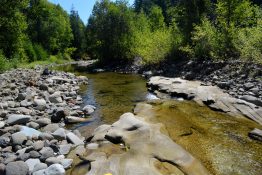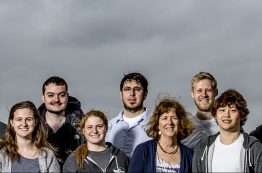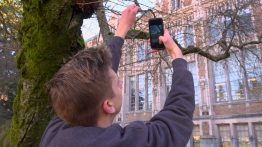Geologic time is supposed to be slow, and the most solid object should be bedrock. But new University of Washington research upends both concepts: Effects of logging show that human activity can significantly erode bedrock, causing geology to fast forward. The study, published April 15 in the Proceedings of the National Academy of Sciences, focuses on the Teanaway River, a picturesque river in central Washington state.
Read more at UW News »UW students win national weather forecasting contest
The University of Washington has won a national competition in which colleges vie to deliver the most accurate daily forecast for cities across the country. A UW student also developed a machine-learning model that for the first time delivered a more accurate forecast than any human competitor. In results announced this week, the UW team placed first among 36 teams in the annual WxChallenge operated by the University of Oklahoma.
Read more at UW News »Congratulations to Abigail Swann, named an Early Career Fellow of the Ecological Society of America (ESA)
Abigail Swann, an associate professor in both the Department of Atmospheric Sciences and the Department of Biology has been named an Early Career Fellow of the Ecological Society of America (ESA). Swann was elected for her impact advancing understanding of linkages between vegetation change and the atmosphere via “ecoclimate teleconnections,” including an understanding of the climate impacts of plant distributions and plant functioning, and of the processes responsible for plant-climate interactions.
Read more »North Dakota site shows wreckage from same object that killed the dinosaurs
In a paper published April 1 in the Proceedings of the National Academy of Sciences an international team of authors, including University of Washington Provost Mark Richards, share the discovery of a site that tells another piece of the story from the day a meteor strike is thought to have led to the end of the dinosaurs. “It’s like a museum of the end of the Cretaceous in a layer a meter and a half thick,” said Richards, who is also a professor in the UW Department of Earth & Space Sciences.
Read more »UW students spearhead efforts to predict peak bloom for cherry trees
Each spring, thousands of visitors flock to the University of Washington campus to see the iconic cherry trees in the Quad. Class discussions, casual Frisbee tosses, lunchtime picnics and even wedding portraits all take place under the beautiful blossoms, which typically hit their prime in late March or early April. This year, they reached peak bloom on March 29. But there’s no easy way to predict when peak bloom will occur each year for the trees in the Quad.
Read more at UW News »





